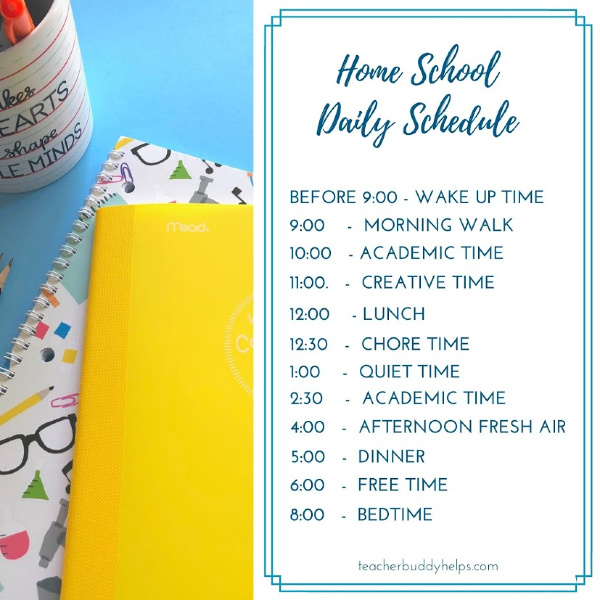Covid-19; 10 Tips for Temporary Home Schooling
Everyone is wondering how to help their children during this time of “Shelter at Home” during this worldwide pandemic. Here are my top 10 Tips for Temporary Home Schooling during this crisis.
While my website, TEACHER BUDDY HELPS is targeted to help new teachers (and other teachers also), I wanted to create this article to help any parents that may be searching for help with the Covid-19 time at home with their children.

Parents are searching for tips and guidance in this uncharted territory. The children are wondering what is going on and missing their classmates and the routine. Parents are trying to either work from home or scramble to get all the household chores done while also teaching their child.
My Top 10 Tips for Temporary Home Schooling
Here is the quick list of my top tips, and after this “quick-list” I will provide a detail description of each tip.
- Don’t let your child witness your uneasiness or anxiety (if possible).
- Create a “do-able” daily schedule.
- Children do not need 5 hours of academics during homeschooling.
- Utilize your teacher’s resources (if provided).
- Reach out to your child’s teacher with questions.
- Provide a “Morning Meeting” time.
- Enjoy this special time with your child.
- If “working from home,” request flexibility from your employer.
- Know when to “STOP” if your child is overwhelmed.
- If you and your child are having problems with the curriculum, put it aside until you can ask the teacher for assistance.
Now here are the details for each item on this Covid-19 Home Schooling list.
#1. Don’t let your child witness your uneasiness or anxiety (if possible).
We are all experiencing uneasiness as we see this pandemic unfold in front of our eyes. We are trying to juggle so many things at once, home school, work from home, getting groceries (yet staying germ-free), cleaning the house to wipe away germs, hand washing, etc.
Of course, there is a lot of anxiety in all of this at this time. BUT, it’s super important to not let this anxiety creep into your child’s world (if possible).
You do need to have a discussion with your child about why they aren’t having school right now. I bet most of you have already done this. But make sure that your explanations fit their age-level. You would not discuss this the same to a 5-year-old Kindergartener as you do to a High School Freshman.
#2. Create a “do-able” daily schedule.

The graphic above is only a sample of a daily schedule you can create. Feel free to take a picture of it with your phone to have handy. If your child is in primary grades, you may want to shorten the academic times and increase the creative playtime.
And reversely, you will want to increase this academic time for older students.
Teachers, in case you are searching for a list of the most important classroom routines, I have a list for you to download for FREE. Just complete this form and I will email it right over to you.
**
#3. Children do not need 5 hours of academics during homeschooling.
As you can see in the sample schedule above, there are 2 1/2 hours of academic time. As already stated, if your child is Middle School or High School, you will want to increase this a bit by using some time in the other areas.
So I’m sure you are wondering “what do we do with all this other time” when you only spend 2 1/2 hours on Academics. If weather permits go outside in your yard or neighborhood. If you live in a big city or an apartment, possibly go to a park (if your city allows it). You and your children both need fresh air. If you can’t go outside, open a window and watch/listen for birds.
At another time in the day bring in arts and crafts or have your children learn about household chores and how to help out at home.
Here is an article that I wrote on the importance of reading aloud with your child. The article is written in regards to teachers reading aloud to their class, but the information is the same for both; How Important is Reading Aloud to Your Class?
#4. Utilize your teacher’s resources (if provided).
Some school districts are requiring or recommending that their teacher provide students (and their parents) with resources for families to use. I am noticing (because I am paying attention nationwide) that the requirements are very different for each district.
Your child’s teacher may be checking in daily. Or sending assignments over a class dojo or email. Perhaps your school has sent a packet of work to be completed. If you haven’t yet heard from your child’s teacher, send him/her an email.
My granddaughter’s school is even providing school lunches (in sacks to take home) if you drive over to the school to get them. My daughter and her kids have been doing this at least three days a week so far.
Look online for resources to use with your child. There are so many online resources for students. Check out Pinterest for some ideas and resources. Some of them even seem like games to the children. Many museums, zoos, national parks and theaters are offering virtual experiences right now. Take advantage of them.
If you don’t have a home computer or tablet that your child can use, contact the school. They may have a process to check one out to your child.
#5. Reach out to your child’s teacher with questions during homeschooling.
If you need help from your child’s teacher, just ask. They are there to offer support and resources. Perhaps you are not sure how to teach a certain math concept. Email or call the teacher and ask. Your child’s teacher knows so much about how your child learns. They have been working with your child for eight months already, so they know your child well.
#6. Provide a “Morning Meeting” time.
I know some of you are wondering what a “morning meeting” is. If your child’s teacher isn’t already doing this with the group, you can start it for your child.
A morning meeting is a time when you discuss the schedule for the day. Talk about things with your child. You can provide a “prompt” or let your child lead the discussion. If your child is in primary grades, some ideas of prompts are: what is your favorite color and why? What is the weather like outside today? Tell me three things that start with the letter “B”, etc.
For older students, this is basically a review of how the day will be structured. What outdoor or craft activity is planned (if there is one planned). Or what assignments has the teacher assigned? Remember all the online “extra” things that were mentioned above for these times.
If the teacher is not providing ideas for this, go online and look for things. You should be planning these things the day before so you are ready to discuss the schedule the next morning during “Morning Meeting.”

#7. Enjoy this special time with your child.
It is so important during this time to create some special experiences with your child. This is the perfect opportunity to work on new projects. I know there have been times when you’ve wanted to do something with your child but didn’t because it was going to be a big project. Well, now is the time to start that project.
Establish a new rhythm for your day. This period of time is like no other that we have experienced in our time. So the best thing you and your children can do is to establish a new rhythm for your day. This falls in line with creating a schedule (the #2 tip above).
I have another good article that can lead to a good discussion with your child (especially the ones from 3rd grade and older. It is called Are You Following the Four Agreements? You Should Be!
#8. If “working from home,” request flexibility from your employer.
Now I know some of you are being asked to “Work from Home” for your paying job. If this is your reality, then my suggestion to you is to talk to your employer and find out if they can allow you a little bit of flexibility with your work. If it is not crucial for you to be available daily from 9 to 5, then possibly you can work in periods of time throughout the day to get in your eight hours of work.
Perhaps you can work before 9:00 am if your child can get his/her own breakfast. Also, put in a half-hour when your child is playing or during a quiet time. Then a bulk of your work can be in the afternoons once the “school work” is finished for the day.
#9. Know when to “STOP” if your child is overwhelmed.
Often parents aren’t sure how much work children can do during a work period. You will have a period of trial and error as you figure out how much work can be accomplished during a work period. If your child is working on a computer software program, the program will easily pick up where your child left off from the previous day. AWESOME!
So, if you see your child getting frustrated, tired or overwhelmed, it’s okay to STOP and move on to another thing.
#10. If you and your child are having problems with the curriculum, put it aside until you can ask the teacher for assistance.
If you are working with your child on something difficult or new and your child is frustrated and not getting it, STOP! It is not worth making both you and your child upset to try to teach/learn the topic right then and there.
Move on to another subject or activity and take a few minutes to either email the teacher or call him/her. I think most have made themselves available to parents and students during this time.
Here are some ideas from a Home Schooling website. The article is “6 Homeschool Routine Ideas Guaranteed Not to be Boring.”
Let me know if you found this useful or if you have other tips I can give to parents of children who are at home right now!
Until Next Time,
Your Teacher Buddy






